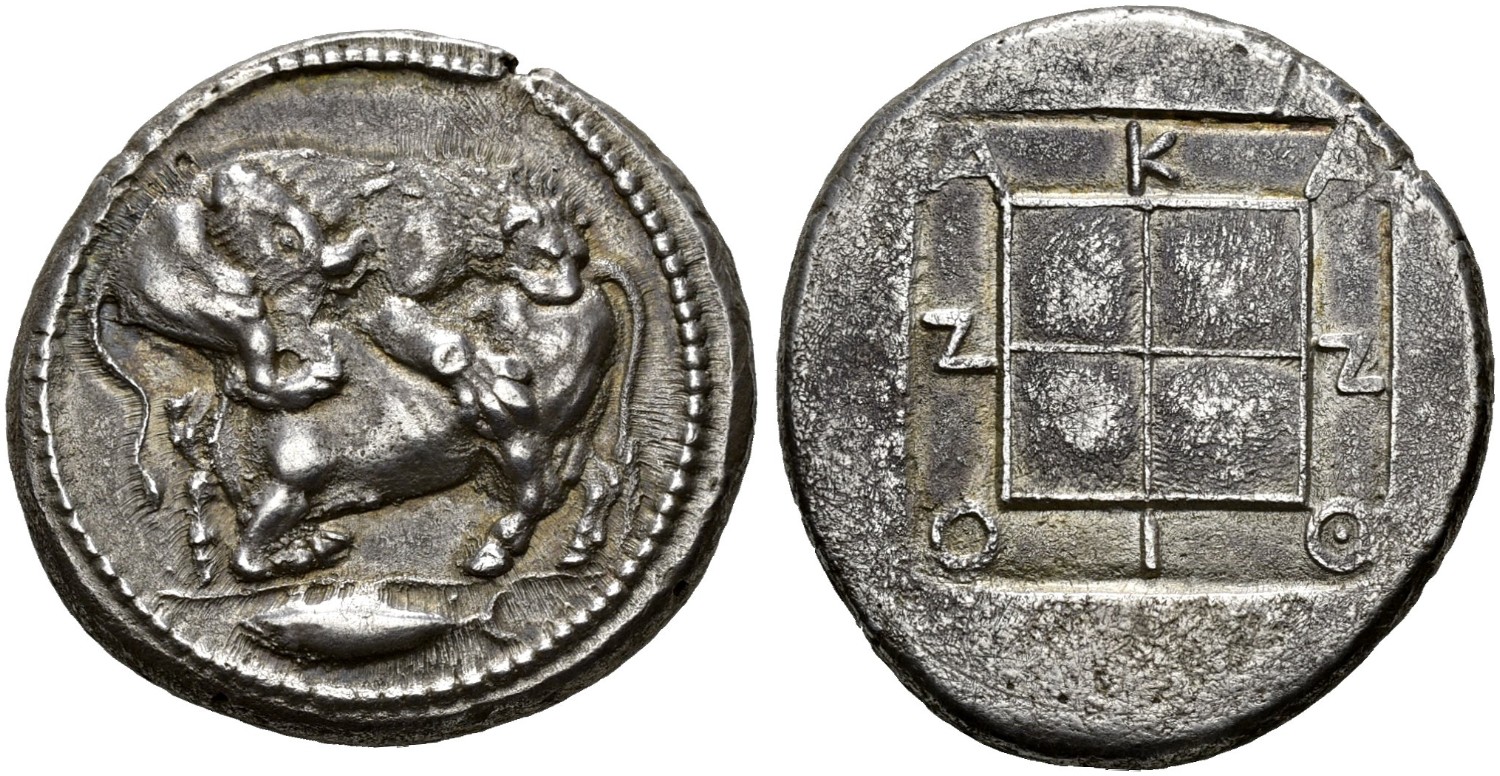AC 147 - Acanthus, silver, tetradrachms (465-424 BCE) Desneux
From SILVER
465 BCE - 424 BCE Silver 31,341 kg
Description
| ObverseInscription or printing placed on the obverse.: | Lion r., attacking kneeling bull, in exergue, tunny l. |
| ReverseInscription or printing placed on the reverse.: | AKANΘION (Greek).Four-part linear square, around, AKA / NΘ /I - ON within shallow incuse square |
Mint and issuing power
| MintIdentifies the place of manufacture or issue of a numismatic object.: | Acanthus | Ancient regionAncient region.: | Macedon | Modern countryModern country: Greece | AuthorityIdentifies the issuing power. The authority can be "pretended" when the name or the portrait of X is on the coin but he/she was not the issuing power. It can also be "uncertain" when there is no mention of X on the coin but he/she was the issuing power according to the historical sources: |
Chronology
| FromIdentifies the initial date in a range assigned in a numismatic context. | 465 BCE | toIdentifies the final date in a range assigned in a numismatic context.. | 424 BCE | PeriodTime period of the numismatic object.: Classical 480-323 BC |
Physical description
| MetalThe physical material (usually metal) from which an object is made.: | Silver |
Median weightMedian of the weights of numismatic objects (in grams). in grams | 17.00 | DenominationTerm indicating the value of a numismatic object. Examples: tetradrachm, chalkous, denarius.: | tetradrachm |
StandardStandard.: |
Image

AC147 Acanthus.jpg [1]
References
| Die study referencePublication of the study: | Desneux 19491Desneux 1949, n° 93-115 | ||
| Coin series referenceReference to coin series study: | Sear I2Sear I, n° 1364-1365, RQEMAC3RQEMAC, n° 147 | ||
Obverse dies distribution
| FrequencyFrequency of specimen in distribution. ᵖ | Number of obversesNumber of obverse dies. ᵖ (o) | % (o) | Number of coinsNumber of coins. (n) | % (n) | Die nameName(s) of the die(s). |
| 1 | 19 | 86.36 | 19 | 70.37 | 90, 91, 92, 93, 94, 95, 96, 97, 98, 99, 100, 101, 102, 103, 105, 106, 107, 108, 109 |
| 2 | 1 | 4.55 | 2 | 7.41 | 111 |
| 3 | 2 | 9.09 | 6 | 22.22 | 104, 110 |
| Total | 22 of 22 | 100 | 27 of 27 | 100 |
Reverse dies distribution
no distribution is available
Quantification
| Number of obversesNumber of obverse dies. ᵖ (o) | 22 | Number of singletons (o1)The number of singleton coins. ᵖ | 19 |
| Number of reverse diesNumber of reverse dies. (r) | 13 | Number of coinsNumber of coins. (n) | 27 |
| Coins per obverse dieNumber of coins per obverse die. (n/o) | 1.23 | Coins per reverse dieNumber of coins per reverse die. (n/r) | 2.08 |
| Reverse per obverse ratioRatio of obverse dies divided by reverse dies. (r/o) | 0.59 | Percentage of singletons (o1)number of coins (n) divided by the number of singletons (o1) ᵖ | 86.36 % |
| Original number of dies (O) (Carter 1983 formula)The estimation of the number of coins according to Carter 1983 ᵖ | 92.18 | Coins struck if 20,000 as average productivity per dieCoins made if the average productivity for obverses (according to Carter) is 20,000. ᵖ | 1,843,600 |
| Original number of dies (O) (Esty 2011 formula)The estimation of the number of coins according to the singleton formula in Esty 2011 ᵖ (O) | 118.8 | Survival rate if 20,000 as average productivity per dieSurvival rate if average productivity is 20,000. ᵖ | 0.00001 |
| Coverage (o = % of O) (Esty 1984 formula)Esty 1984 - coverage (% of O) ᵖ (o = % of O) | 29.63% | Die productivity if survival rate 1/2,000Average productivity if survival rate is 1/2,000. ᵖ | 585.81 |
| Weight of silver (in kg) if 20,000 coins per die (O = Carter formula)Carter 1983 * Median weight * 20000 (*10 if gold or electrum) ᵖ | 31,341 kg <br /> 31,341 kg | Die productivity if survival rate 1/5,000Average productivity if survival rate is 1/5,000. ᵖ | 1,464.53 |
Remarks